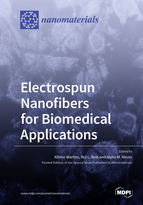Electrospun Nanofibers for Biomedical Applications
A special issue of Nanomaterials (ISSN 2079-4991).
Deadline for manuscript submissions: closed (20 February 2019) | Viewed by 97747
Special Issue Editors
Interests: surface biofunctionalization; drug delivery systems; fibrous scaffolds; mesenchymal stem cells
Interests: natural origin materials; marine-derived materials; biomaterials processing; porous scaffolds; tissue engineering; regenerative medicine; stem cells; biomimetics; biodegradables; drug delivery; nanotechnology; polymer chemistry; bioceramics; microfluidics; 3D in-vitro cancer models; biodegradable urological stents
Special Issues, Collections and Topics in MDPI journals
Interests: biodegradable biomaterials; polymer science; porous biomaterials; natural origin biomaterials; surface biofunctionalization of biomaterials; nanostructured biomaterials and composites; bone and cartilage tissue engineering; adult stem cells; advanced therapies; regenerative medicine; animal models for testing of biomaterials
Special Issues, Collections and Topics in MDPI journals
Special Issue Information
Dear Colleagues,
Nanomaterial-based solutions are amongst the most promising therapies to face the increasing incidences of cancer, cardiovascular, respiratory, musculoskeletal and neurodegenerative diseases, associated with the aging of the world population. Nanofibers have already been proposed as devices for a wide range of applications. In particular, the unique properties of electrospun nanofibers have supported the development of highly effective therapeutic solutions to many unmet clinical needs.
This Special Issue aims at assembling a set of highly-innovative contributions on the most advanced solutions and therapies based on or involving electrospun meshes, as well as radical new strategies to extend its applicability. Of particular interest are papers tackling the following research topics:
- scaffolds structure and functionalization for tissue engineering and regenerative medicine;
- delivery systems for drugs/proteins/genes;
- bioactive wound dressings;
- membranes for different medical applications including filtration and dialysis;
- imaging and biosensing for disease diagnostics and/or prognosis.
Dr. Albino Martins
Prof. Dr. Rui L. Reis
Prof. Dr. Nuno M. Neves
Guest Editors
Manuscript Submission Information
Manuscripts should be submitted online at www.mdpi.com by registering and logging in to this website. Once you are registered, click here to go to the submission form. Manuscripts can be submitted until the deadline. All submissions that pass pre-check are peer-reviewed. Accepted papers will be published continuously in the journal (as soon as accepted) and will be listed together on the special issue website. Research articles, review articles as well as short communications are invited. For planned papers, a title and short abstract (about 100 words) can be sent to the Editorial Office for announcement on this website.
Submitted manuscripts should not have been published previously, nor be under consideration for publication elsewhere (except conference proceedings papers). All manuscripts are thoroughly refereed through a single-blind peer-review process. A guide for authors and other relevant information for submission of manuscripts is available on the Instructions for Authors page. Nanomaterials is an international peer-reviewed open access semimonthly journal published by MDPI.
Please visit the Instructions for Authors page before submitting a manuscript. The Article Processing Charge (APC) for publication in this open access journal is 2900 CHF (Swiss Francs). Submitted papers should be well formatted and use good English. Authors may use MDPI's English editing service prior to publication or during author revisions.
Keywords
- Electrospinning
- Tissue Engineering and Regenerative Medicine
- Drug Delivery Systems
- Wound dressing
- Filtration and dialysis
- Imaging
- Biosensing








